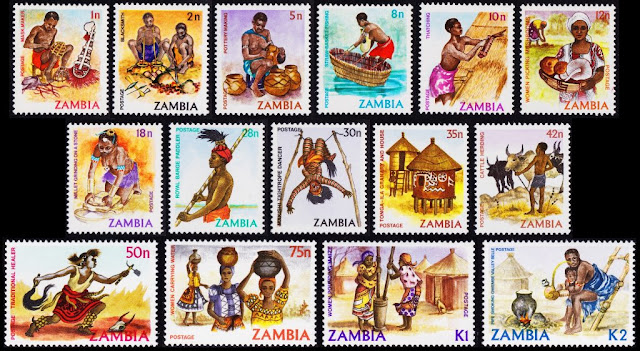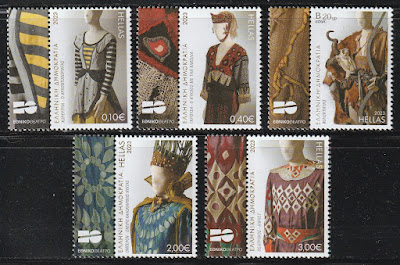GOOD DAY FRIENDS! THIS BLOG ONLY SHOW MY THEME COLLECTIONS: COSTUMES, DANCES, CULTURES, FOLKLORES, ORIGINAL INHABITANT, UNIFORM MILITARY, & COAT OF ARMS... IF YOU WANT TO SWAP WITH ME, PLEASE DON'T HESITATE TO CONTACT ME AT jefferson_sie@yahoo.com BEST WISHES, JEFFERSON
Sunday, August 13, 2023
Thursday, August 10, 2023
United Nation 2023 - Body, Mind and Soul
Technical Details:
Date of Issue: 10 August 2023
Artist: Yun Zhang (P.R. China)
Designer: Rorie Katz (United Nations)
Stamp denominations: US$ 0.66, CHF 1,10, € 1,00
Stamp size: 40 mm x 30 mm
Sheet size: 180 mm x 170 mm
Stamps per sheet: 20
Souvenir sheet denominations: US$ 1.50, CHF 2,30, € 1,90
Souvenir sheet size: 40 mm x 140 mm with a 30 mm x 40 mm stamp
Printer: Royal Joh Enschedé (The Netherlands)
Process: Offset lithography
Perforation: 14 x 13 ¼
Quantities Stamps:
US$ 0.66 = 12,000 sheets
CHF 1,10 = 12,000 sheets
€ 1,00 = 12,000 sheets
Souvenir sheets:
US$ 1.50 = 37,000
CHF 2,30 = 27,000
€ 1,90 = 29,000
The Designs
US$ 0.66 stamp and US$ 1.50 souvenir sheet – Taijiquan
CHF 1,10 stamp and CHF 2,30 souvenir sheet – Chinese Calligraphy
€ 1,00 stamp and € 1,90 souvenir sheet – Guqin and its music
Saturday, August 5, 2023
Andorra Spanish - Dance of The Bear
Issue Date: 22 February 2022
About Dance of the Bear
The ball de l'ossa d'Encamp is a popular theatrical and dance performance around a bear hunt that takes place on Carnival Monday in the parish of Encamp, Andorra. In the first half of the twentieth century the tradition was lost and the dances of the bear were disappearing from the Principality. In Encamp, the dance of the bear revived in the fifties by the journalist and writer Rossend Marsol Clua (Sícoris), who formalized its representation. The dance of the bear of Encamp together with the Last Bear of Ordino that is celebrated in the first week of December in this other parish, are the only manifestations that survive of this ancestral Andorran tradition. These two festivals are included in the General Inventory of the Cultural Heritage of the Government of Andorra as Intangible Assets, and their inclusion in the Intangible Cultural Heritage of Humanity of UNESCO is also being processed.
The Andorra Bear Festival is considered a theatrical farce, in other words, a one-act comedy performance. This festival features a variety of characters typical of Andorran rural life of the last century and the hunting of the animal is presented as a pretext to stage the trifles in which they are immersed. At the end of the performance, garlic and quince oil are distributed to all attendees.
Friday, August 4, 2023
Thursday, August 3, 2023
Singapore 1986 - World Fair "EXPO '86" - Vancouver, Canada
 |
Date of Issued: 02 may 1986
Denomination: 50c, 75c, SGD1
Stamp Size: 40mm x 28mm
Perforation: 14.5
Paper: Unwatermarked
Printing Process: Offset Lithography
Printer: Leigh Mardon Pty Ltd
Sheet Content: 30 Stamps per Sheet
Designer: Chua Ban Har
SGD 0.50 - Calligrapher
SGD 0.75 - Garland Marker
SGD 1.00 - Batik Printer
COMMEMORATIVE STAMPS EXPO '86 will be one of the greatest attractions the world is likely to see in this decade and millions of people of every age and interest are expected to visit the grounds in Vancouver, British Columbia, Canada between 2 May and 13 October 1986.
EXPO '86 will also be the largest special category World Exposition ever staged in North America and the first to focus on the latest innovations in transportation and communications. It will attempt to seek new ways to overcome the barriers of time and space, new methods of people, goods and ideas.
With the theme of "World in World in Touch", EXPO'86 will offer a glimpse of both the marvels of modern technology and the re-enactments of past travels.
Singapore is participating with a Singapore Pavilion and an overall theme of "Sur- prising Singapore”.
In conjunction with the World Exposition, a set of three stamps will be issued on 2 May 1986.
Interwoven into the fabric of Singapore's modern city life and highly sophisticated industries is a surprising myriad of traditional trades and handicrafts which have thrived in the little cor- ners of Singapore for a few decades.
Depicted on the 50¢ stamp is calligra- phy, which is the skill of Chinese hand- writing. Using the supple Chinese writing brush and paper, the calligrapher trans- poses the ideographic Chinese character into pieces of art, each in its distinctive beauty, grace and style. Calligraphy is a traditional art, coming from a time when a good hand is equated with good education. Lines and strokes cannot be corrected once they are written.
In Singapore, calligraphers can be found in Chinatown. Their history started from those early days when letter writers were needed as links of family communi- cation for young men who come to make their homes in Singapore. Today, they write poems, couplets, names and even greetings as souvenirs for both tourists and locals alike.
Garland makers (as depicted on the 75¢ stamp) are found along the stretch of Serangoon Road, affectionately known as the "Little India" of Singapore.
The art originated from India, and has evolved somewhat to meet the needs of other ethnic communities in Singapore. Originally using the jasmine blossom, garland makers in Singapore today make use of red and pink roses and orchids to string their garlands together.
As with the traditional crafts, the trade of garland making goes back a few decades. The skill is a relatively simple one using strips of banana fibre to tie the stems of flowers together, forming an attractive floral string. A variety of flowers is used, the most com- mon being the jasmine blossom, chosen for its sweet scent and used in Hindu religious cere- monies. Garlands are also made for use as women's hair pieces, in ritual baths and at wedding
and engagement ceremonies.
Batik printing (on the $1 stamp) in Singapore had its ori- gin from the neigh- bouring countries of Indonesia and Malaysia. There are three methods of making batik- hand-painted, hand-stamped and machine printed. In its original form, batik printing is an ornate skill, using a tedious wax and dye process to work out rich patterns and designs on cloth, producing unique master- pieces, often without duplicate.
Batik in Singapore is produced largely for exports. The designs in Singapore batiks tend to centre on the floral theme and are intricate and fine. They are prin- ted on a variety of fabric materials such as cotton, silk and rayon, and are fashion- ed into wrap-around skirts, sundresses, shirts, blouses and, of course, the striking traditional sarong worn by ladies.








